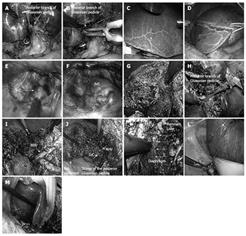Copyright
©2013 Baishideng Publishing Group Co.
World J Gastrointest Surg. Jun 27, 2013; 5(6): 173-177
Published online Jun 27, 2013. doi: 10.4240/wjgs.v5.i6.173
Published online Jun 27, 2013. doi: 10.4240/wjgs.v5.i6.173
Figure 4 Intraoperative findings of the case.
A-D: Part I; E-H: Part II; I, J: Part III; K-M: Part IV. After cholecystectomy, Glissonian pedicle of the right lobe and posterior sector was encircled (A). The posterior pedicle was clamped (B), allowing the resection line to be visualized as; an ischemic demarcation line (C, D). E, F: The anterior wall of the inferior vena cava was dissected behind the liver; G: Liver parenchyma was transected on the demarcation line, and the peripheral part of the right hepatic vein was exposed, clipped, and divided; H: After the cutting line reached the level of Glissonian, the posterior pedicle was divided with a linear stapler. Transection of the liver and the exposure of the right hepatic vein (RHV) by dividing its posterior branched one-by-one proceeded in one direction from caudal to cranial, simultaneously with the dissection of the inferior vena cava anterior wall. Since remnants of the liver sunk down and the resected liver was fixed to the retroperitoneum, the cutting surface was well opened and the exposure of the RHV was facilitated. K: Following completion of the liver parenchymal transection; L: Dissection of the resected liver from retroperitoneum was performed; M: The resected liver was removed. Dissection of the resected liver from retroperitoneum was easily performed with the use of gravity. The operation time was 341 min and operative blood loss was 1356 mL. The patient’s postoperative hospital stay was uneventful and she was well without any signs of recurrences one year and two months after surgery.
- Citation: Tomishige H, Morise Z, Kawabe N, Nagata H, Ohshima H, Kawase J, Arakawa S, Yoshida R, Isetani M. Caudal approach to pure laparoscopic posterior sectionectomy under the laparoscopy-specific view. World J Gastrointest Surg 2013; 5(6): 173-177
- URL: https://www.wjgnet.com/1948-9366/full/v5/i6/173.htm
- DOI: https://dx.doi.org/10.4240/wjgs.v5.i6.173









